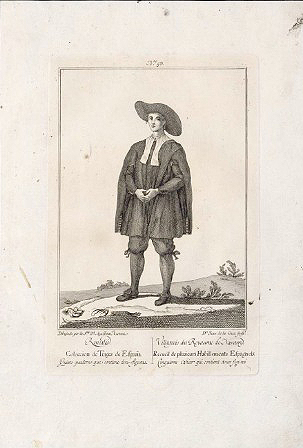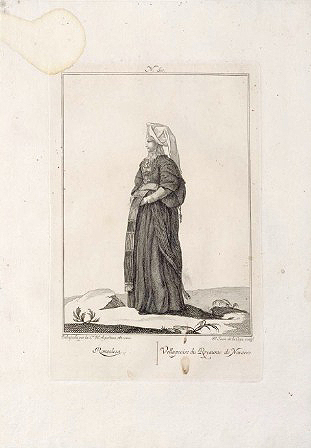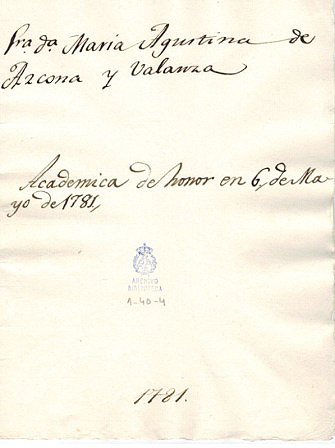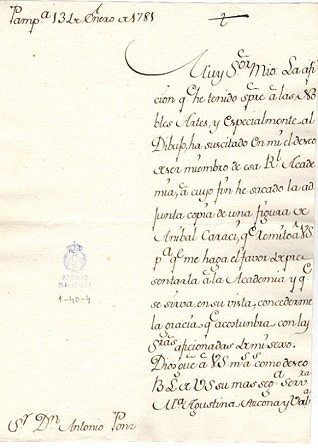The piece of the month of March 2015
THE DRAWINGS FOR ENGRAVINGS OF AGUSTINA AZCONA, AN ACADEMIC FROM NAVARRA OF SAN FERNANDO IN THE EIGHTEENTH CENTURY
José Ignacio Riezu Boj
research center in Nutrition
University of Navarra
In the middle of the 16th century, the first collections and books illustrated with engravings showing the clothing or types of the different countries or regions of the world appeared in Europe. These engravings were soon a great success, which led to their reprinting and the appearance of new collections that spread throughout the continent. The first collection of costume engravings appeared in France in 1562 with the edition of Richard Breton and François Deprez. The work, entitled Recueil de la diversité des Habits qui sont des present en usaige tant es Pays D'Europe, Asie, Afrique, et isles sauvages, Le tout fait apres le naturel, contains 121 prints attributed to Enea Vico showing the ways of dressing throughout the world, distinguishing also social classes and exotic curiosities. This work, which had several editions, was quickly followed by other publications in Venice (Bertelli, 1563), Nuremberg (Weigel, 1577), Cologne (Bruyn, 1577 and 1581), Malines in Flanders (Boissard, 1581), Rome (Grassi, 1585), Padua (Bertelli, 1589, 1591 and 1596) and Venice (Vecellio, 1590), which reveal the great success of this subject of illustrations in the second half of the 16th century.
In Spain, this subject of engravings arrived two centuries late, by the hand of Juan de la Cruz Cano y Olmedilla. The author, born in Madrid in 1734 although with ancestry from Huesca, had been trained as an engraver in Paris thanks to a scholarship of the Royal Academy of Fine Arts of San Fernando between 1752 and 1760. On his return to Madrid he was appointed supernumerary academician of the Academy of San Fernando and later merit academician in 1764. On September 2, 1777 he begins the edition of his engravings titled Collection of suits of Spain, so much ancient as modern, That comprehends all those of its Dominions, Divided in two Volumes with eight quaderns of to twelve Engravings each one: Disposed and Engraved, By D. Juan de la Cruz Cano and Holmedilla Geographer Pensionado of S. M. and individual of the Royal Academies of S. Fernando, and Society Bascongada of the Friends of the Country. The collection of engravings, according to the advertisements in the press of the time, was sold in the bookshop of Copin, degree program of San Gerónimo, two by two at about 36 reales. In addition to his important collection of costumes, Juan de la Cruz, has gone down in history for being the author of one of the most important maps of South America. This work, was a royal commission that took him 10 years and although it was the best map of America ever drawn, it was discarded and discredited due to political problems. Juan de la Cruz, after spending a few years of prosperity being the royal cartographer, and seeing himself relegated from his work, had to look for another way of life. These seem to be the reasons that induced him to undertake the novel business for Spain of a collection of engravings of costumes that had become so popular in Europe.
During the first five years, 50 engravings of very varied themes were published, although those of a geographical nature predominated over those of a social or labor nature (popular trades, couples with Spanish regional clothing, costumbrist prints, clothing from the American possessions or famous bullfighters). All the prints were numbered on the upper part of the plate and have at the bottom a text in Spanish and French and generally the pair of prints published at the same time are pairs of man and woman. On April 9, 1782 the Gaceta de Madrid announces the publication of the engravings nº 49 and 50 that represent a Roncalés and a Roncalesa. These works are the first graphic representations of the Roncalese clothing of which we have news. Other Navarrese costumes, such as those of Pamplona or Roncesvalles, had already appeared in the first European collections of the 16th century, but never the Roncalese costume.

Roncalés (Collection of Spanish Costumes), engraving by Juan de la Cruz on a drawing by María Agustina de Azcona.
(Library Services National)
The engravings represent a man with the typical Roncal cape, still used today by the Roncal councillors on some important occasions, and a woman with a very different attire to the current Roncal costume. This difference in women's attire is not surprising, since the profound changes that Roncalese women's clothing underwent during the 18th century are well documented. Changes that made the headdresses and head cloths change to mantillas, the portetas, sleeves and aprons to dungarees and doublets and the sayas and basquiñas to top and bottom skirts.

Roncalesa (Collection of Spanish Costumes), engraving by Juan de la Cruz on a drawing by María Agustina de Azcona.
(Library Services National)
These engravings of Roncal types, although no longer representing contemporary women's clothing, were profusely copied throughout the 18th, 19th and 20th centuries, with more than fifteen national and international versions of the same models being published well into the 20th century. Among the most outstanding editions are those of Teodoro Viero (Venice 1783), Jacques Grasser de Sant-Sauveur (Paris 1784 and 1806), Sylvain Maréchal (Paris 1788 and 1837), Antonio Rodríguez (Madrid 1804), Jean Baptiste Breton de Martiniere (Paris 1815), Giscard (London 1822) or Edme-Jean Pigal (Paris 1825).
The engravings by Juan de la Cruz are signed by the engraver himself and by a draughtswoman, Mrs. Agustina Azcona. The author requested in the beginning of his work that "the curious ones of outside or inside the Court that liked to communicate some drawing of little known costumes and existing in some Town, Valley, or Serrania of the Peninsula, will be rewarded with as many quadernos, as figures remit in Letter, or without her, to this author lives in Madrid street Calle del Principe Nº 11 quarto segundo" and this seems to have happened with the prints 49 and 50. It seems that Agustina Azcona sent drawings of the Roncaleses and Juan de la Cruz made the engraving plates. Other contemporary artists and painters also collaborated with the engraver, such as his nephew Manuel de la Cruz or Antonio Carnicero, Guillermo Ferrer, Luis Paret y Alcazar or Alfonso Bergaz.
We know little about Agustina Azcona's identity. What we have located of her, thanks to the financial aid of professor Ricardo Fernández Gracia is the following: She was born in Pamplona and was baptized in San Saturnino on October 1, 1755 with the name María Agustina Remigia Fermina. Her father was Ignacio Azcona y Carrillo, a nobleman from Navarre, knight of the order of Carlos III, who studied law and canons at the University of Irache and Valladolid and held, among others, the positions of mayor of Pamplona, mayor of San Sebastián and oidor of the royal committee of Navarre. His mother was Córdula Balanza y Olaegui, chambermaid of the Virgen del Camino and sister of Fermina, wife of the Marquis de la Real Defensa. Agustina Azcona was an honorary member of the Royal Academy of Fine Arts of San Fernando. We have located the application of admission to the institution on January 3, 1871, in which with careful handwriting she explains "the fondness I have had for the noble arts and especially for drawing has aroused in me the desire to be a member of that Royal Academy for which purpose I have taken the attached copy of a figure of Anibal Caraci that I send...". María Agustina was named honorary academician on May 6, 1781, being one of the first women to become a member of such an illustrious institution to which our engraver also belonged. María Agustina married José Crespo in Logroño and died in that city on January 11, 1808. We do not know any other work of this Navarrese painter.

Cover of the transcript for the appointment of María Agustina de Azcona y Balanza as honorary academician.
(file of the Royal Academy of Fine Arts of San Fernando)

Letter from María Agustina de Azcona addressed to Antonio Ponz, secretary of the Royal Academy of Fine Arts, requesting her access as an academician to the institution.
(file de la Real Academia de Bellas Artes de San Fernando)
Many questions arise with our author: Where did she learn to paint? Are there any of her paintings left in Navarre? What connection did she have with the Roncal Valley? Why didn't she draw the costumes of Pamplona? Perhaps she no longer differed much from the fashions of Madrid? Our future historians will have to work hard to solve these and many other questions.
SOURCES AND bibliography
-file Real Academia de Bellas Artes de San Fernando, 1-40-4: transcript de María Agustina Azcona y Balanza,
-HUALDE, F., Indumentaria roncalesa, Ediciones Lamiñarra, Pamplona, 2013.
-RIEZU-BOJ, J.I., "El traje tradicional roncalés en documentos notariales del Valle de Roncal", Cuadernos de Etnología y Etnografía de Navarra, 87, 2012, pp. 155-212.
-RODRÍGUEZ, A., Colección general de los trajes de Madrid (facsimile ed. by J. Carrete Parrondo), Madrid, Ayuntamiento de Madrid, 1989.
-GONZÁLEZ MARTÍNEZ, R. M., "Funcionarios en la administración borbónica. Cambios y permanencias (1700-1750)", Investigaciones históricas: Época moderna y contemporánea, 26, 2006, pp. 137-161.
-GONZÁLEZ FUERTES, M. A., "¿Vistiendo España? Costumes and national identity in the reign of Charles III", Cuadernos de Historia Moderna, XI, 2012, pp. 73-105.
-Trajesen papel: grabados de indumentaria vasca, siglos XVI-XIX, Bilbao, Museo Arqueológico, Etnográfico e Histórico Vasco, 2004.
